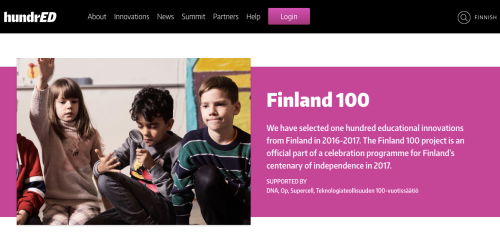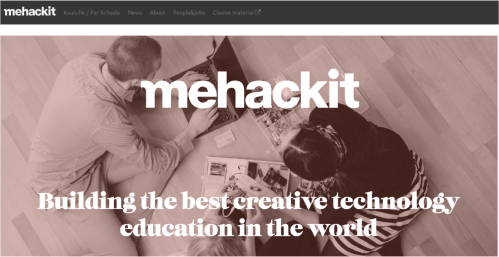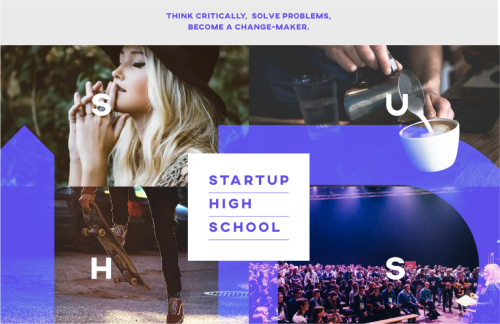This post is a part of a series of reflections by Thomas Hatch, of Teachers College, Columbia University, on efforts to improve education around the world, originally posted on thomashatch.org. You can trace these emerging themes on the global landscape for education innovation by visiting posts on Estonia, Singapore, Malaysia, and South Africa.
Finland has been hailed for having one of the best education systems in the world; criticized as scores on international assessments have slipped; and, most recently, flooded with questions about whether it is dramatically changing its education system by making conventional subjects “a thing of the past.” Whether you believe Finland’s education system is moving up or down on some set of rankings, it’s clear that there are some teachers, school leaders, and other educators who are trying to do some things differently. The challenge as Saku Tuominen describes it, is “not pushing new ideas into schools, but trying to identify innovative ideas that are already out there” and helping them spread. As he joked, the problem is that “whatever happens in the classroom, stays in the classroom.”
To address this problem, Tuominen founded HundrED to find promising educational innovations around the world. HundrED just released its list of 100 global innovations from Afghanistan to Venezuela and many places in between. Last year, in a kind of test-run for their global work, Tuominen and his colleagues identified 100 Finnish educational innovations that they have documented and shared online. During my most recent visit to Helsinki last summer, I had the chance to meet with a few of the education innovators on the Finnish list as well as with policymakers and colleagues from a variety of other Finnish educational institutions. All those with whom I talked not only emphasized that their work begins with a recognition of and respect for the autonomy of teachers and a commitment to basic principles of equity, but also expressed some frustration with the difficulties and slow-pace of improving and changing the Finnish education system. At the same time, those conversations pointed to key avenues for supporting the development of new and more effective educational practices at both the policy and the school level.

Policies for change
At the policy level, as Anneli Rautiainen, Head of the newly formed Innovation Center at the Finnish National Agency for Education, explains, Finland has two primary means of influencing education: the curriculum renewal process and the launch of specific policy initiatives. The curriculum renewal process takes place roughly every 10 years and includes an extensive period for public discussion and feedback on potential changes in the national curriculum framework. As a result, Rautiainen explained, “almost everyone can have a say in what children should learn.” As part of that process, municipalities and local schools also have considerable autonomy in deciding how to implement any changes. The previous curriculum renewal process in 2004 concentrated on the development of the school as a holistic learning environment for students, but the most recent curriculum renewal process emphasizes “phenomenon-based” learning and “transversal” competences that cut across traditional school subjects. Although the new framework does not eradicate subject-based teaching, it stipulates that all students should participate each year in a multi-disciplinary learning module. Those modules are to be designed locally by teachers, with the expectation that students will be involved in the planning.
As with all policy initiatives, some teachers and schools are already off and running. In fact, as part of the earlier emphasis on developing a holistic learning environment some have already pioneered approaches that include multi-disciplinary projects. For example, in Fiskars, a community in Finland well-known for its artisans and craft-workers, the local school has expanded the learning environment to include the whole village. As a result, students regularly participate in workshops that focus on topics like glass blowing and historically based theatre productions. As a consequence, the school is already well positioned to respond to the expectations for carrying out interdisciplinary projects in the new curriculum framework.
In addition to trying to move the system forward through the curriculum renewal process, the Finnish National Agency for Education also carries out what have been translated as “spear” projects – targeted efforts to support the implementation of other policy priorities. Most recently, those projects have included an initiative in which municipalities have been invited to apply for funding to enable a teacher in a school to support the professional learning of colleagues by co-teaching, modeling or coaching. “One of our biggest aims,” Rautiainen pointed out “is to have schools become professional learning communities, and to support learning at work, rather than taking a course somewhere else,” and this project is one way of putting that aim into practice. Another project encourages experimentation among municipalities that want to provide instruction in foreign language in earlier grades (before 3rd grade where it begins in most schools now). An ongoing project designed to get schools “on the move” was launched in 2010 to increase students’ physical activity during the school day and included the expectation that all students in Basic Education should have at least one hour of exercise every day.
Courses for change
Mehackit and Startup High School, two of the Finnish educational innovations highlighted by HundrED, have found a different place within the conventional education system where new approaches may take root. Both organizations take advantage of the fact that at the upper secondary level (roughly ages 16-18) students have to take roughly 50 compulsory courses, but students can choose the topics for about 25 other courses. In Mehackit’s case, they began about 2013 by offering workshops and “clubs” to engage young children in programming and coding – making things with technology, not just using technology. But, as current CEO, Heini Karppinen, explained, Mehackit’s founders are part of a new generation of social entrepreneurs trying to respond to a context where “there are a lot of services that people would like to have, but that they don’t get anymore from the government.” In this case, the founders discovered that those children who attended Mehackit’s clubs and maker-fairs often had parents who were already tech-savvy and working in technology related jobs. They worried that children who didn’t have parents in tech-related fields would ultimately graduate high school without having experienced the “maker-side” of technology. To reach all children, the founders felt they needed a way to work within the formal education system. As the new curriculum framework in 2016 also included computer programming for the first time, they saw a “niche” in working with older students, where teaching programming required sophisticated technical knowledge and skills that relatively few Finnish teachers possess.

In response to this opportunity, Mehackit created 2 courses for 16-18 year old students that teach programming through projects focused on robotics and electronic music projects and creating multimedia art and graphics. The courses are designed so that they can be offered by schools around Finland (and Mehackit has already exported them to Sweden and the UK as well) as easily and efficiently as possible. Mehackit not only provides teaching materials, they also hire and train instructors, many of whom are university students working on technology related degrees. While Mehackit is a for-profit company and schools and municipalities purchase the courses, Mehackit also has a shorter workshop course for 12 to 16-year-old students; provides freely available open source materials; offers a new materials kit at cost; and has created teacher training workshops so that teacher can develop their own, comparable, courses.

Startup High School has taken a similar approach to Mehackit. Although Startup High School may eventually create a high school for entrepreneurial studies (along the lines of subject specific schools in Finland that focus on music, the arts, and sports), they are set to begin with an offering of three courses in the fall of 2017. (Pekka Peura, a teacher whose work I highlighted in “Brand-name” teachers in Finland, is one of the founders of Startup High School.) Those courses are designed to enable students from a number of different upper secondary schools to learn “how to think critically, how to solve problems, and how to be a change maker.” In developing the courses, the founders seek to create the kinds of student-centered, active, and multidisciplinary learning opportunities emphasized in the new curriculum that they described as rarely emphasized in Finland’s typically highly-academically oriented high schools. Courses will include original video interviews with a variety of Finnish entrepreneurs and artists, including CEO’s, rappers, actors, and dj’s that students will access as they develop their own Linked-in profiles and plans and portfolios illustrating their own design ideas. Perhaps most importantly, the founders emphasize, students should leave the course as part of a network of peers with common entrepreneurial interests, connected via social media. While Startup High School could charge for the courses, their plan is to make the courses widely available for free or perhaps with a nominal registration fee that, along with contributions from sponsors, would help to cover their costs.
Although Mehackit essentially delivers the instructors and materials to each school with whom they partner (and they map and track exactly where they are in reaching out to all schools across Finland), Startup High School offers virtual courses that they lead and administer themselves and that students in a number of different high schools can take as one of their 25 elective courses. In both cases, Mehackit and Startup High School are offering new topics and approaches as part of modules or “plug-ins” that not only fit within current course demands and expectations in Finland, but can also be offered as a conventional course in many other education systems.
Opportunities and challenges
The new ideas and approaches endorsed by policymakers and highlighted by HundrED demonstrate how Finland’s national curriculum framework can support and encourage those who want to change their approach to teaching and learning. But the autonomy that teachers and schools in Finland enjoy also means that many can choose not to change their practice quickly or deeply. As Rautiainen puts it, the framework and policy initiatives can “nudge” the system, but by no means guarantees that changes will be made. For example, while some reports indicate that over 90% of Finnish municipalities are participating in the “on the move” initiatives, concerns remain about exactly how it has been implemented and how it is playing out for all students.
Those I talked to acknowledged that there are number of factors that might encourage and reinforce those who choose to use their autonomy to maintain more conventional classroom and school practices. For one thing, while the new curriculum framework adds expectations for students to engage in interdisciplinary projects, little, if anything, has been left out of the “old” curriculum. Like Singapore’s effort to create ‘white space” in the curriculum, the changes in the national curriculum framework in Finland try to squeeze more into the conventional curriculum and school day.
But at the same time that some elements of the framework change, many elements of the system remain the same and reinforce conventional practice. Even without high-stakes annual testing like that in the US, the high-stakes exit exams at the end of high school help to align the whole system, but they also serve as constraints reinforcing the traditional divisions between subjects. Conventional textbooks provide similar constraints. As Antti Rajala, a former teacher and currently a researcher at the University of Helsinki noted, even as they benefit from high-quality textbooks, teachers who are trying to innovate sometimes see “the textbook as an enemy.” As a consequence, as Peura explained, one of the first steps he and others make to change their teaching is to go beyond the textbook.
Along with the autonomy of teachers comes a highly independent teaching force. Teachers can choose their own professional development plans, and, in many cases, can choose to pursue their work on their own, rather than in collaboration with their colleagues. Peura reported that on one small survey he asked teachers why they don’t share their work more often, and their overwhelming response was that “colleagues” were the biggest obstacle. Peura sees the concerns that Finnish teachers have about changing as understandable, but notes that it means that when one or two teachers do try to make their work public or share it more widely, peers often object.
Perhaps most problematic, this commitment to autonomy runs smack up against Finland’s deep commitment to equity: if early adopters take off with the interdisciplinary projects but others do not, learning experiences across Finland are likely to become less and less comparable. In fact, those I spoke to were less concerned about overall decreases in average test schools and much more concerned that the PISA results and the results of the national monitoring tests are showing that student outcomes are more differentiated and less equitable than they have been in the past. Illustrating the inherent tension between the autonomy of teachers and the rights of students, Rajala told me that in one of the schools where he is working the principal had to deal with the fact that several of the teachers did not want to incorporate an emphasis on digital skills into their teaching. In order to respect their autonomy while still ensuring that all the students got the same digital learning experiences as their peers, the principal had to figure out a way to schedule students so that they all got a chance to work with those teachers who were actively working to incorporate digital skills into their classrooms.
Given all of these factors, in a system largely considered to be “working,” with few incentives to change, it should be no surprise that many both inside and outside the education system see maintaining the status quo as a sensible way to operate. That’s why from Tuominen’s perspective, the key issue is to find those innovations that are working – where there is both a clear and widespread need and where the knowledge, skills, and resources to make the necessary changes are also already available. He cites as examples “the gaming room”, which, essentially provides the plans and materials so that schools can quickly and easily create a place where students can access the most effective educational games and use them during recess and other points during the school day. Similarly, the “house of learning” provides a set of stand-alone tools that help students to plan, track and assess their own learning, without requiring extensive training. Tuominen does not expect all the “innovations” that HundrED identifies in Finland or globally to take off, but he believes that initiatives like HundrED can help to highlight and spread those that are gaining traction. In the meantime, however, since the Finnish system is designed to “steer” not to penalize, there will be no grading, sanctions, or public humiliation. But changing the education system will continue to be a subject of public discussion in Finland, particularly when the next curriculum renewal takes place.
Thomas Hatch, Teachers College, Columbia University